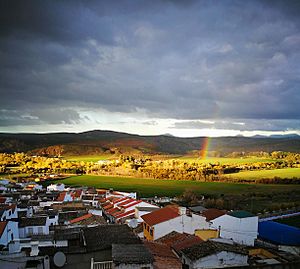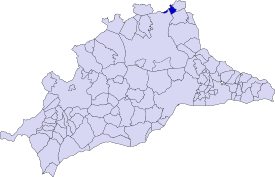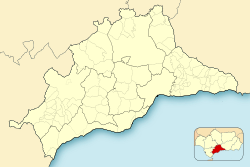Cuevas Bajas facts for kids
Quick facts for kids
Cuevas Bajas
|
||
|---|---|---|
 |
||
|
||
| Sovereign state | ||
| Autonomous community | ||
| Province | ||
| Comarca | Antequera | |
| Area | ||
| • Total | 17 km2 (7 sq mi) | |
| Elevation | 312 m (1,024 ft) | |
| Population
(2018)
|
||
| • Total | 1,392 | |
| • Density | 81.9/km2 (212/sq mi) | |
| Demonym(s) | Cueveños | |
| Time zone | UTC+1 (CET) | |
| • Summer (DST) | UTC+2 (CEST) | |
| Postal code |
29220
|
|
| Website | http://www.cuevasbajas.es | |
 |
||
Cuevas Bajas is a charming town in the province of Málaga, located in southern Spain. It's part of the autonomous community of Andalusia. This small town belongs to the Nororma area, which is a group of towns.
In 2018, about 1,392 people lived here. The town covers an area of 17 square kilometers. People from Cuevas Bajas are called Cueveños. The town is about 75 kilometers from the city of Málaga.
Contents
Exploring Cuevas Bajas: Geography and Location
Cuevas Bajas is nestled in a beautiful valley. The Genil River flows nearby, adding to the scenic views. The town is on the northern edge of the Antequera region.
The village has a classic Andalusian look. You'll find short, narrow streets. The houses often have pretty barred windows and balconies. Cuevas Bajas is located 312 meters above sea level.
A Journey Through Time: History of Cuevas Bajas
The area around Cuevas Bajas has a very long history. People lived here as far back as the Paleolithic Age. This is known from old tools found near the town. These tools were discovered along the river terraces of the Genil.
During the Roman times, around 200 BC, an important Roman road passed close to Cuevas Bajas. This road was listed in an old Roman travel guide called the Itinerary of Antonio. Many Roman villas, or country homes, were also in the area. Their remains have been found over time.
After the Arab rule, the area was taken over in 1426. This happened when the Alcaide (a type of governor) of Antequera, D. Fernando de Narváez, conquered the square. Land was then given out, and the town of Cuevas Bajas slowly began to grow and repopulate.
Must-See Sights: Monuments of Cuevas Bajas
Cuevas Bajas has some interesting places to visit.
Church of San Juan Bautista
One of the most important buildings is the Church of San Juan Bautista. This church was built in the 18th century. It's a great example of the architecture from that time.
Village Architecture
The main street of Cuevas Bajas is also worth seeing. Many of the buildings keep the traditional architecture of the region. The village of Kidron also shows off this typical style. You can see how people lived long ago.
See also
 In Spanish: Cuevas Bajas para niños
In Spanish: Cuevas Bajas para niños





